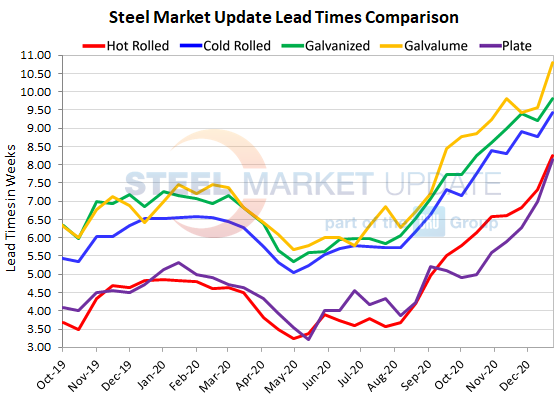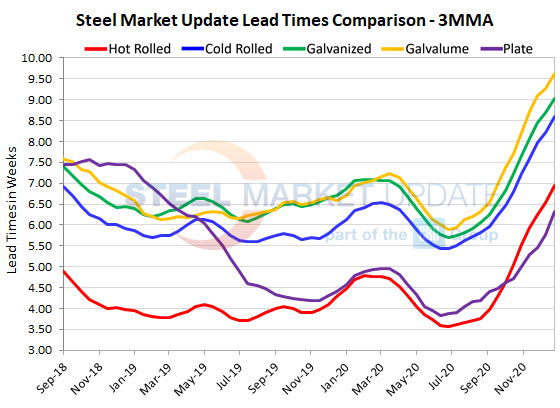SMU Data and Models

Steel Mill Lead Times: Hot Rolled Extends to Eight Weeks
Written by Tim Triplett
December 22, 2020
Steel Market Update’s check of the market a few days before Christmas shows no let-up in steel demand, as prices continue to rise and lead times continue to extend. With steel supplies remaining extremely tight, lead times for deliveries of hot rolled have stretched to more than eight weeks and coated steel orders to around 10 weeks. Lead times are an indicator of steel demand—longer lead times mean the mills are busy and less likely to negotiate on price.
Current hot rolled lead times average 8.24 weeks, up from 7.31 two weeks ago. HR lead times have extended by five weeks since hitting 3.25 weeks at the low point in April.
Cold rolled lead times are at 9.44 weeks, up from 8.77 two weeks ago. Like hot rolled, cold rolled lead times are more than a month longer than in late April.
Galvanized lead times now average 9.81 weeks, up from 9.21 two weeks ago—about four and a half weeks longer than the low point this spring. Similarly, the current average Galvalume lead time is out to 10.80 weeks.
Demand for plate products has clearly improved as the mills are collecting at least some of their recent price increases. Plate lead times have seen the most change, extending to 8.13 weeks from 7.00 weeks earlier in December. Plate lead times bottomed at 3.20 weeks back in May.
Viewed as three-month moving averages to smooth out the volatility, hot rolled lead times have continued to extend to 6.95 weeks, cold rolled 8.60 weeks, galvanized 9.04 weeks, Galvalume 9.62 weeks and plate 6.32 weeks.
Note: These lead times are based on the average from manufacturers and steel service centers who participated in this week’s SMU market trends analysis. Our lead times do not predict what any individual may get from any specific mill supplier. Look to your mill rep for actual lead times. Our lead times are meant only to identify trends and changes in the marketplace. To see an interactive history of our Steel Mill Lead Times data, visit our website here.



Tim Triplett
Read more from Tim TriplettLatest in SMU Data and Models

SMU Survey: Sheet lead times ease further, plate hits one-year high
Steel buyers responding to this week’s SMU market survey report a continued softening in sheet lead times. Meanwhile, plate lead times have moderately extended and are at a one-year high.

SMU Survey: Buyers report more price flexibility from mills
Nearly half of the steel buyers responding to this week’s SMU market survey say domestic mills are showing increased willingness to negotiate pricing on new spot orders. This marks a significant shift from the firmer stance mills held in prior weeks.

SMU Survey: Buyers’ Sentiment Indices fall
Current Sentiment Index dropped six points to +42 this week compared to two weeks earlier. It has fallen in every successive survey since reaching a 2025 high of +66 on Feb. 19.

March service center shipments and inventories report
Steel service center shipments and inventories report through March 2024.

Apparent steel supply contracts in February
The amount of finished steel that entered the US market in February receded from January’s peak, according to our analysis of Department of Commerce and American Iron and Steel Institute (AISI) data.
